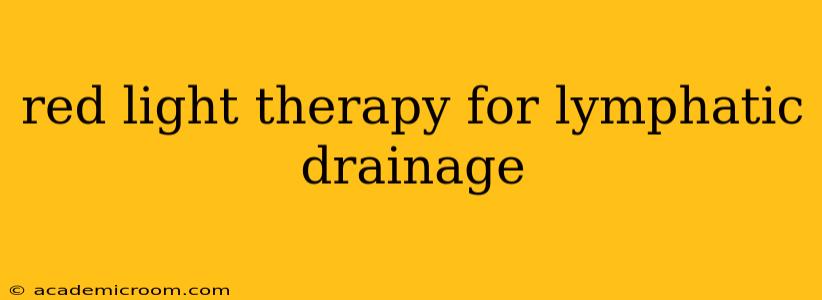Red light therapy (RLT), also known as low-level laser therapy (LLLT), has gained popularity for its purported benefits in various health and wellness areas. One emerging application is its use for lymphatic drainage. While research is still ongoing, many believe RLT can stimulate lymphatic flow and potentially alleviate symptoms associated with lymphatic congestion. This article explores the potential benefits, mechanisms, and considerations surrounding the use of red light therapy for lymphatic drainage.
What is Lymphatic Drainage?
Before diving into the specifics of red light therapy, let's understand the lymphatic system. This network of vessels and nodes plays a crucial role in removing waste products, toxins, and excess fluid from the body. Proper lymphatic drainage is vital for immune function and overall well-being. When lymphatic drainage is compromised, fluid can accumulate, leading to swelling (edema), inflammation, and other health issues.
How Does Red Light Therapy Work for Lymphatic Drainage?
The proposed mechanism behind RLT's effect on lymphatic drainage lies in its ability to stimulate cellular activity. Red light, specifically wavelengths around 630-660nm, is believed to penetrate the skin and interact with mitochondria, the powerhouses of cells. This interaction may increase cellular energy production (ATP), potentially leading to:
- Increased circulation: Improved blood flow can enhance the lymphatic system's efficiency in removing waste.
- Reduced inflammation: RLT's anti-inflammatory effects can lessen swelling and improve lymphatic flow.
- Stimulated lymphatic pump: Some suggest RLT might directly stimulate the contraction of lymphatic smooth muscle, promoting lymphatic drainage.
It's crucial to note that the exact mechanisms are still under investigation, and more research is needed to fully understand the effects of RLT on lymphatic drainage.
Does Red Light Therapy Really Help with Lymphatic Drainage?
While anecdotal evidence and some preliminary studies suggest potential benefits, more robust clinical trials are needed to definitively prove the efficacy of RLT for lymphatic drainage. Current research is promising but inconclusive. The observed improvements might also be due to other factors, such as relaxation and improved blood circulation, which are often associated with RLT treatments.
What are the Benefits of Red Light Therapy for Lymphatic Drainage?
Potential benefits reported by users and some studies include:
- Reduced swelling: Many individuals report a decrease in swelling, particularly in the extremities.
- Improved skin tone: Increased circulation may contribute to a healthier, more radiant complexion.
- Pain reduction: Reduced inflammation may alleviate pain associated with lymphatic congestion.
- Improved immune function: Enhanced lymphatic drainage might support a stronger immune system.
It is vital to reiterate that these benefits are largely based on anecdotal evidence and preliminary research. More comprehensive studies are needed to confirm these claims.
What are the Potential Side Effects of Red Light Therapy?
Red light therapy is generally considered safe, with minimal side effects. However, some individuals may experience:
- Mild skin redness or warmth: This is usually temporary and resolves quickly.
- Eye irritation: Always wear protective eyewear during treatment to avoid eye damage.
Severe side effects are rare. If you experience any unusual symptoms, discontinue treatment and consult a healthcare professional.
How Often Should I Use Red Light Therapy for Lymphatic Drainage?
The frequency of treatment varies depending on individual needs and the severity of lymphatic congestion. Many recommend daily or several times a week sessions, each lasting for 10-20 minutes. However, it's best to consult with a healthcare professional or experienced RLT practitioner to determine a suitable treatment plan.
Is Red Light Therapy a Cure for Lymphatic Issues?
No. Red light therapy is not a cure for lymphatic disorders. It's a complementary therapy that may help support lymphatic drainage and alleviate associated symptoms. Serious lymphatic conditions require professional medical attention and treatment. RLT should be considered a supportive therapy, not a replacement for conventional medical care.
Conclusion
Red light therapy shows promise as a supportive therapy for lymphatic drainage, but further research is necessary to validate its effectiveness. While many individuals report positive experiences, it's crucial to manage expectations and understand that RLT is not a cure-all for lymphatic issues. If you are considering using RLT for lymphatic drainage, consult with a healthcare professional to assess its suitability for your specific situation and to discuss potential risks and benefits. Always prioritize evidence-based treatments and professional medical advice for serious health concerns.
